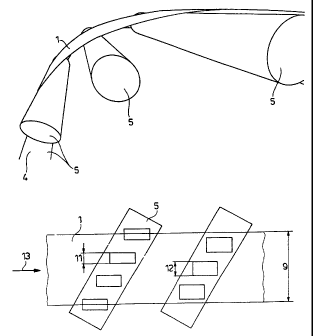Une partie des informations de ce site Web a été fournie par des sources externes. Le gouvernement du Canada n'assume aucune responsabilité concernant la précision, l'actualité ou la fiabilité des informations fournies par les sources externes. Les utilisateurs qui désirent employer cette information devraient consulter directement la source des informations. Le contenu fourni par les sources externes n'est pas assujetti aux exigences sur les langues officielles, la protection des renseignements personnels et l'accessibilité.
L'apparition de différences dans le texte et l'image des Revendications et de l'Abrégé dépend du moment auquel le document est publié. Les textes des Revendications et de l'Abrégé sont affichés :
| (12) Brevet: | (11) CA 2448850 |
|---|---|
| (54) Titre français: | DISPOSITIF POUR RETOURNER DES BANDES |
| (54) Titre anglais: | DEVICE FOR TURNING STRIPS |
| Statut: | Réputé périmé |
| (51) Classification internationale des brevets (CIB): |
|
|---|---|
| (72) Inventeurs : |
|
| (73) Titulaires : |
|
| (71) Demandeurs : |
|
| (74) Agent: | RICHES, MCKENZIE & HERBERT LLP |
| (74) Co-agent: | |
| (45) Délivré: | 2010-01-26 |
| (86) Date de dépôt PCT: | 2002-05-31 |
| (87) Mise à la disponibilité du public: | 2002-12-19 |
| Requête d'examen: | 2007-05-01 |
| Licence disponible: | S.O. |
| (25) Langue des documents déposés: | Anglais |
| Traité de coopération en matière de brevets (PCT): | Oui |
|---|---|
| (86) Numéro de la demande PCT: | PCT/EP2002/006007 |
| (87) Numéro de publication internationale PCT: | WO2002/100749 |
| (85) Entrée nationale: | 2003-11-20 |
| (30) Données de priorité de la demande: | ||||||
|---|---|---|---|---|---|---|
|
L'invention concerne un procédé pour retourner des bandes (1) et modifier leur sens d'avance, ce procédé s'appliquant en particulier à une bande mince à chaud. Selon ce procédé, la bande peut être retournée selon un angle voulu par l'intermédiaire d'au moins un rouleau de retournement au moyen de bancs de rouleaux (5) disposés à la périphérie du rouleau de retournement, ces bancs comprenant chacun plusieurs rouleaux individuels (11, 12). Selon l'invention, pour éviter les déformations plastiques et élastiques, la bande est soutenue en différents points par les rouleaux individuels de bancs de rouleaux (5) successifs. L'invention concerne également un dispositif permettant de mettre en oeuvre ce procédé. Dans ce dispositif, les bancs de rouleaux placés les uns derrière les autres dans le sens de retournement de la bande sont décalés les uns par rapport aux autres de telle sorte que les surfaces de contact de leurs rouleaux avec la bande soient décalées d'une largeur de rouleau (11, 12) de banc à banc.
The invention relates to a method for turning and reorienting the displacement
direction of strips (1), especially of a thin hot strip. The strip can be
turned about any angle by means of at least one deflection roller, with roller
banks (5) which are arranged on the circumference of the deflection roller,
and which respectively comprise a plurality of individual rollers. Plastic and
elastic deformations are avoided due to the fact that the strip is supported
at various points by the individual rollers of successive roller banks (5).
The invention also relates to a device for carrying out the method. Said
device enables the roller banks placed one after the other in the strip
deflection direction to be staggered in relation to each other in such a way
that the contact surfaces of their rollers with the strip are staggered from
bank to bank, by one roller width (11,12).
Note : Les revendications sont présentées dans la langue officielle dans laquelle elles ont été soumises.
Note : Les descriptions sont présentées dans la langue officielle dans laquelle elles ont été soumises.

Pour une meilleure compréhension de l'état de la demande ou brevet qui figure sur cette page, la rubrique Mise en garde , et les descriptions de Brevet , États administratifs , Taxes périodiques et Historique des paiements devraient être consultées.
| Titre | Date |
|---|---|
| Date de délivrance prévu | 2010-01-26 |
| (86) Date de dépôt PCT | 2002-05-31 |
| (87) Date de publication PCT | 2002-12-19 |
| (85) Entrée nationale | 2003-11-20 |
| Requête d'examen | 2007-05-01 |
| (45) Délivré | 2010-01-26 |
| Réputé périmé | 2011-05-31 |
Il n'y a pas d'historique d'abandonnement
| Type de taxes | Anniversaire | Échéance | Montant payé | Date payée |
|---|---|---|---|---|
| Enregistrement de documents | 100,00 $ | 2003-11-20 | ||
| Le dépôt d'une demande de brevet | 300,00 $ | 2003-11-20 | ||
| Taxe de maintien en état - Demande - nouvelle loi | 2 | 2004-05-31 | 100,00 $ | 2003-11-20 |
| Taxe de maintien en état - Demande - nouvelle loi | 3 | 2005-05-31 | 100,00 $ | 2005-04-29 |
| Taxe de maintien en état - Demande - nouvelle loi | 4 | 2006-05-31 | 100,00 $ | 2006-04-26 |
| Requête d'examen | 800,00 $ | 2007-05-01 | ||
| Taxe de maintien en état - Demande - nouvelle loi | 5 | 2007-05-31 | 200,00 $ | 2007-05-10 |
| Taxe de maintien en état - Demande - nouvelle loi | 6 | 2008-06-02 | 200,00 $ | 2008-05-22 |
| Taxe de maintien en état - Demande - nouvelle loi | 7 | 2009-06-01 | 200,00 $ | 2009-04-29 |
| Enregistrement de documents | 100,00 $ | 2009-09-09 | ||
| Taxe finale | 300,00 $ | 2009-09-14 |
Les titulaires actuels et antérieures au dossier sont affichés en ordre alphabétique.
| Titulaires actuels au dossier |
|---|
| SMS SIEMAG AKTIENGESELLSCHAFT |
| Titulaires antérieures au dossier |
|---|
| BUENTEN, ROLF |
| RICHERT, WITHOLD |
| SMS DEMAG AKTIENGESELLSCHAFT |